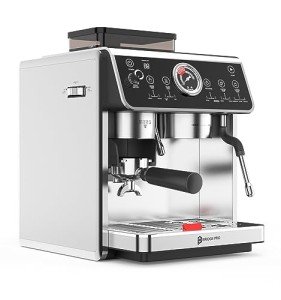The World of High-Quality Espresso Machines: A Comprehensive Guide
Espresso has actually ended up being a cherished drink among coffee enthusiasts worldwide, understood for its abundant flavor, intense scent, and adaptability. The heart of a terrific espresso lies in the machine used to brew it. High-quality espresso machines are created to provide the perfect shot, making them a vital financial investment for coffee lovers. This short article explores different kinds of high-quality espresso machines, their functions, maintenance suggestions, and answers to frequently asked concerns.
Kinds Of High-Quality Espresso Machines
High-quality espresso machines fall into numerous classifications, catering to various choices, ability levels, and budgets. The primary types consist of:
| Type of Machine | Description | Ideal User |
|---|---|---|
| Manual Espresso Machines | Requires user ability to manage extraction and pressure. Provides the most control over the developing procedure. | Experienced baristas and enthusiasts |
| Semi-Automatic Machines | Combines manual operation with automation. Users control the grind and tamping, while the machine handles water dispersion. | Intermediate users |
| Automatic Espresso Machines | Automate the brewing procedure, enabling for programmable brewing times and temperatures. | Casual coffee drinkers |
| Super-Automatic Machines | Have integrated mills and are fully automated, managing everything from grinding to brewing and steaming. | Users seeking convenience |
| Commercial Espresso Machines | Created for high volume use in coffee shops and restaurants, providing sturdiness and speed. | Company owner |
Detailed Overview of Each Type
Manual Espresso Machines
- Pros: Complete control over the brewing process; can produce remarkable quality espresso.
- Cons: Requires substantial skill; lengthy.
Semi-Automatic Machines
- Pros: Balanced control, blending manual and automatic procedures; exceptional quality espresso is still possible.
- Cons: Requires some understanding and experience to master.
Automatic Espresso Machines
- Pros: User-friendly; decreases the finding out curve while still producing high-quality espresso.
- Cons: Still requires some understanding of coffee-making fundamentals.
Super-Automatic Machines
- Pros: Maximal benefit; little skill required; suitable for people or families who desire coffee without fuss.
- Cons: Higher price point; may lack the fine-tuning abilities of manual machines.
Commercial Espresso Machines
- Pros: Built for durability and efficiency; typically includes features for high-volume turns.
- Cons: Expensive; may be overkill for home use.
Secret Features to Consider
When searching for a high-quality espresso machine, a number of key functions must be taken into consideration:
- Pressure and Pump Type: Look for machines with a minimum of 9 bars of pressure, which is vital for extracting the best taste from coffee beans.
- Boiler Type: Single, double, and heat exchanger boilers each impact how the machine performs and the speed of developing.
- Construct Quality: High-quality products such as stainless steel are preferable for resilience and aesthetic appeals.
- Alleviate of Use and Cleaning: Some machines require extensive cleansing, while others are developed for easy maintenance.
- Temperature Control: Consistent temperature is critical; consider machines with PID controllers for exact control.
Advantages of High-Quality Espresso Machines
Purchasing a high-quality espresso machine offers a wide variety of benefits:
- Superior Quality: High-end machines permit greater control, causing more delicious espresso.
- Toughness: Built to last, quality machines require fewer repair work and replacements.
- Customization: Users can delight in a customized experience by adjusting grind size, shot timing, and other settings.
- Increased Convenience: Automatic and super-automatic options enable aficionados to take pleasure in espresso with minimal effort.
Maintenance and Care for High-Quality Espresso Machines
To keep an espresso machine working optimally, regular upkeep is important. Here are suggestions for preserving a high-quality espresso machine:
Descale Regularly:
- Use a descaling solution every couple of months to avoid buildup of minerals from water, which can affect flavor and performance.
Tidy the Brew Group:
- For machines with a removable brew group, tidy it frequently to make sure a tidy extraction.
Replace Water Filters:
- Use a water filter and change it as required to decrease pollutants in your brewing water.
Daily Cleanings:
- Rinse the portafilter and group head after each use to avoid oil accumulation.
Keep an Eye on the Parts:
- Monitor seals, gaskets, and other parts for wear and tear and change them as needed.
Often Asked Questions (FAQs)
1. What is the best espresso machine for beginners?
For novices, a semi-automatic machine frequently offers a good balance of functionality and control, permitting users to discover the abilities required for making fantastic espresso.
2. Are Compact Espresso Machines -automatic machines worth the financial investment?
Yes, for those who focus on convenience and ease over control, super-automatic machines can be a worthwhile investment, especially for households or hectic professionals.
3. Just how much should I expect to spend on a high-quality espresso machine?
High-quality espresso machines range significantly in price, with manual machines starting at a couple of hundred dollars, while super-automatic or commercial machines can surpass several thousand.
4. Can I make other coffee beverages with an espresso machine?
Yes, many espresso machines have steam wands or attachments that enable users to develop lattes, coffees, and more.
5. How long do espresso Retro Espresso Machines ?
With correct maintenance, high-quality espresso machines can last over a decade, making them a long-lasting investment in your coffee enjoyment.
High-quality espresso machines yield a transformative coffee experience, whether delighted in in your home or in a commercial setting. By comprehending the types available, their functions, and the upkeep needed to keep them running efficiently, consumers can make educated decisions that raise their coffee-drinking experience.

